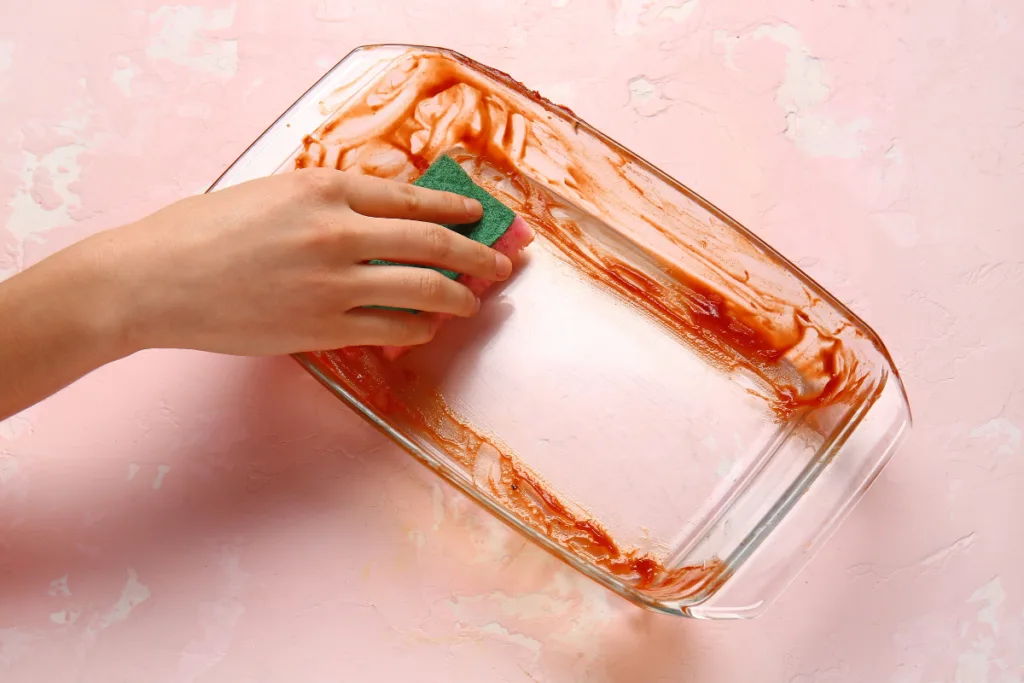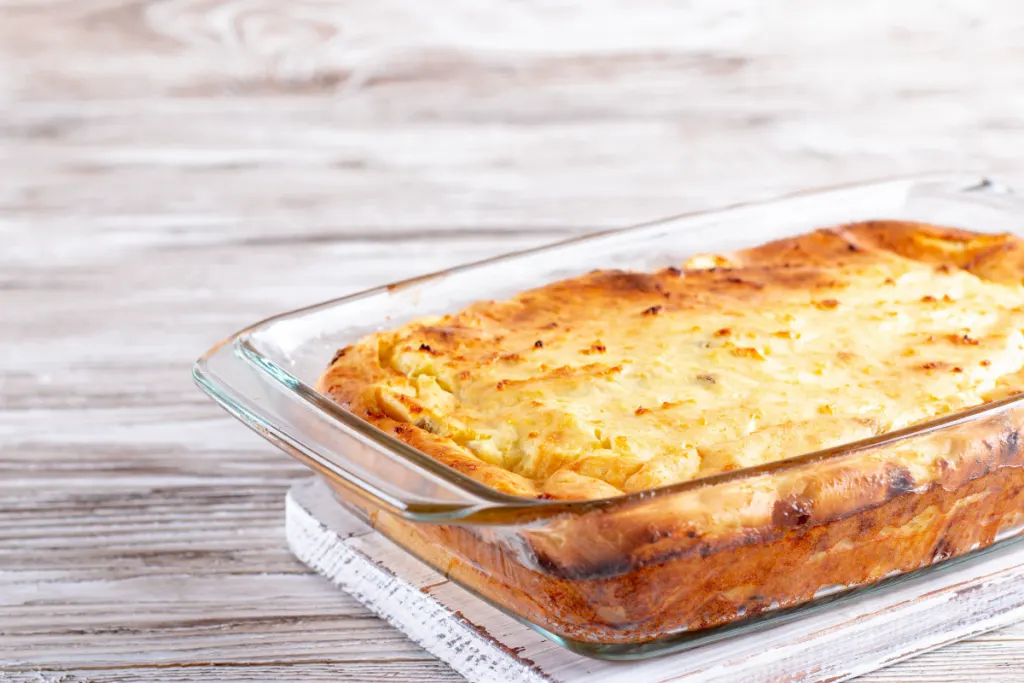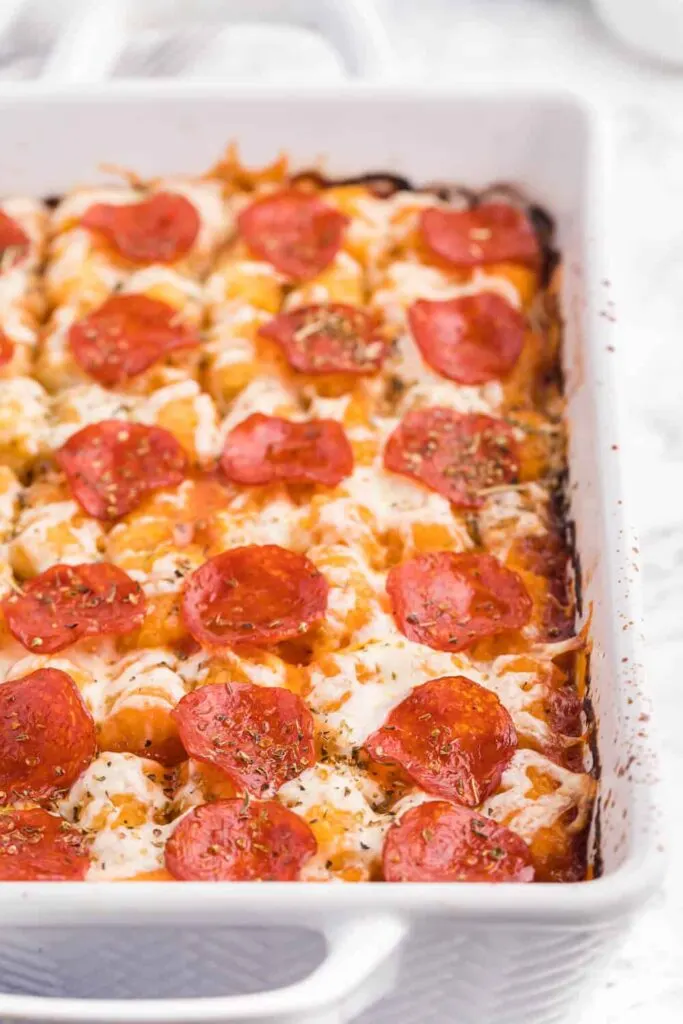Discover the ultimate guide on how to clean a glass baking dish effortlessly. Say goodbye to stubborn stains and residue with our expert tips and tricks.

A good glass baking dish, like pyrex dishes, is like the unsung hero of the kitchen, quietly supporting your casseroles, roasts, and sweet treats. But after the meal, they’re like, “Hey, give us a good scrub, will ya?” For home chefs and busy parents, knowing how to clean these trusty bakeware buddies is a big deal for safety and hygiene. This guide is your partner in crime for keeping those glass baking dishes free from baked-on grease, sparkling clean and ready for action!
The Science Behind the Stain
Let’s tackle the cleaning puzzle! Ever wonder why those pyrex casserole pan end up with stubborn stains?
Picture this: sizzling oven heat, tasty tomato sauces, and rich balsamic glazes – all clinging onto the glass, creating those hard-to-remove marks and stuck-on grease.
Your usual cleaning routine might not cut it with these food residue, stubborn spots and pesky stains.

Tools of the Trade
In addition to a little elbow grease, when it comes to battling these stubborn stains, you’ll need a trusty set of tools. What I love best is that these are the same techniques for cleaning cookie sheets. Here’s your go-to checklist:
White Vinegar
White vinegar, an ancient elixir, has a talent for tackling grime without the harsh chemicals! Plus, it’s eco-friendly and safe.
Baking Soda
This trusty kitchen essential works wonders, gently buffing away tough residues without a scratch on your glassware.
Dish Soap
A reliable sidekick, dish soap effortlessly tackles greasy stains when mixed with warm water. I love Dawn dish soap because it is a tried and true brand.
Soft Bristle Brush or Non-Abrasive Sponge
For a friendly, yet effective, scrubbing solution, a soft sponge is a perfect cleaning tool. Soft bristle brushes and a soft sponge work wonders to remove grime without scratching your casserole dish.
Microfiber Cloth or Paper Towels
These handy tools work wonders on your glassware, giving them that extra sparkle.

Get Rid of the Grime
Here’s your roadmap to bring your glass dishes back to spotless perfection where you might even catch a glimpse of yourself. A little bit of elbow grease goes a long way on this daunting task.
Step 1: The Preliminary Rinse
Begin by removing any leftover food particles from the dish and give it a thorough rinse in hot water. The heat can help soften and dislodge some of the residual grime. Using boiling water is a way to take this to a new level. It is great for a glass bakeware that is full of baked-on food.
Step 2: The Vinegar Solution
Create a vinegar cleaning solution consisting of one part white vinegar to two parts water. Submerge your dish and allow it to soak for 15-20 minutes. The acidity will begin to dissolve the tough stains, scuff marks and any trapped particles.
Step 3: Baking Soda Method
The next step is the bring out the baking soda. Once the vinegar has worked its magic, drain the solution and sprinkle baking soda all over the dish. Now, add a few drops of dish soap and a splash of warm water. This concoction will fizz and form a baking soda paste—the perfect medium with which to scrub away the remaining blemishes.
Step 4: The Brush-Off
With your soft bristle brush or non-abrasive sponge, gently scrub the dish, paying extra attention to areas of heavy staining. The combination of the baking soda and warm water should make this a much easier task.
Step 5: The Final Rites
Rinse your dish thoroughly with hot water. Check to see if any stains remain. If so, repeat the previous steps until the dish is free from marks.

The Common Mistakes to Avoid
Despite your best efforts, some well-meaning techniques can actually exacerbate the issue. Here are mistakes to steer clear of:
Using Steel Wool or Abrasive Pads
While these might be a last resort for some serious staining, they can scratch the glass, leading to more problems than they solve.
Ignoring the Dish After Use
Leaving a stained dish to sit can make the marks harder to remove. Tackle the cleaning as soon as the dish cools down after use to prevent long-term staining.
Overusing the Dishwasher
The harsh detergents and heat cycles of a dishwasher can cause etching in the glass, which not only looks bad but also weakens the dish over time.

Pro Tips
Take your glass dish cleaning to the next level with these pro tips:
A Lemon Save
For particularly pungent dishes, slice a lemon and bake it in the dish for 30 minutes. Follow with a soak in hot, soapy water.
The Magic Eraser Technique
For tough, crusty build-up, a non-toxic melamine foam sponge (this is the sponges that are often called magic eraser) can work wonders. Wet the sponge and use it to tackle the difficult spots with gentle, even strokes.
The Foil Ball Sponge
Aluminum foil, crumpled into a ball, can aid in the scrubbing effort. Its rounded shape effectively buffs out stains with minimal abrasion. This is one of those easy to do hacks that so many people overthink. It is really just a ball of aluminum foil that is great to use during the cleaning process.
The Boiling Remedy
If all else fails, boil some water in the dish and add two tablespoons of baking soda. After the solution cools, scrub and rinse. The heat and baking soda will usually tackle even the most ardent of marks.

Final Thoughts
Caring for your glass cookware goes beyond appearance; it’s about ensuring their longevity and safe cooking practices. By sidestepping cleaning slip-ups and using effective methods, you can extend the lifespan of your dishes and keep them looking pristine. Remember, consistency and gentle handling are key. Now get ready to cook your next culinary masterpiece.
